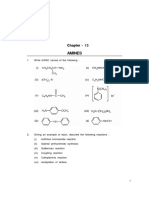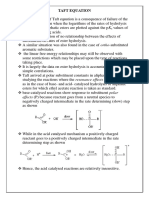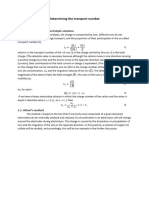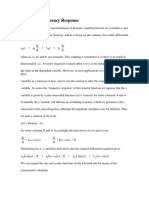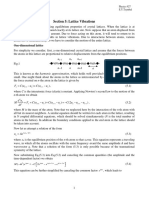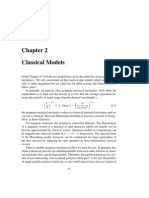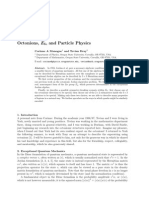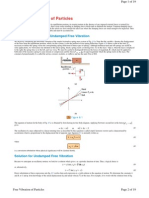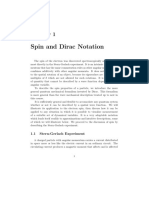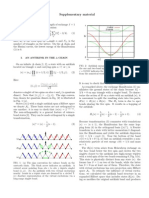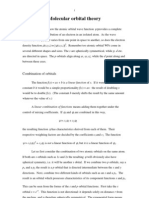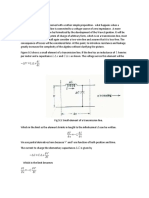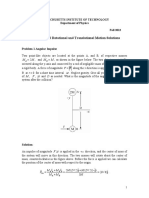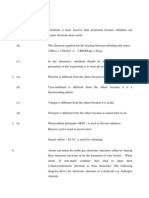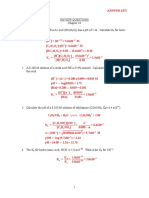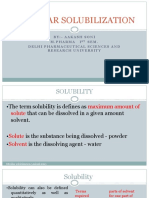Vanishing Integrals
Vanishing Integrals
Uploaded by
Constanza Ruiz NuñezCopyright:
Available Formats
Vanishing Integrals
Vanishing Integrals
Uploaded by
Constanza Ruiz NuñezCopyright
Available Formats
Share this document
Did you find this document useful?
Is this content inappropriate?
Copyright:
Available Formats
Vanishing Integrals
Vanishing Integrals
Uploaded by
Constanza Ruiz NuñezCopyright:
Available Formats
Vanishing integrals
The utility of the direct product of irreducible representations is extensive. Lets
look, for example, at applications of the direct product in applications of quantum
mechanics. Revisiting the property of orthonormal basis sets of eigenfunctions we found
[Eq. (2.18)]
(6.7) !
m
*
!
n
dx
"#
#
$
= %
mn
A symmetry operation leaves the molecule in an indistinguishable orientation with the
same electron density e!
m
*
!
m
( )
and energy as the original. For the case of non-
degenerate eigenvalues the effect of the symmetry operator on the wavefunction is to
leave it unchanged or at most change its sign
(6.8)
O!
m
= 1 ( )!
m
.
Moving through each of the symmetry operations in a group we arrive at an irreducible
representation for !
m
. Thus, the wavefunctions in the integral in Eq. (6.7) can be
replaced by one of the irreducible representations for the group. In Chapter 2 we found
that, at least for one-dimensional problems, the integrand !
m
*
!
n
had to be an even
function of x otherwise the integral would vanish. The test for an even function was that
upon the inversion of the x-coordinate the function remained the same, i.e. ,
f (x) = f (!x) , and f (x) is symmetric with respect to inversion of x . The same holds
true for the molecular wavefunctions in that !
m
*
!
n
must be symmetric with respect to
every operation in the group, i.e., the totally symmetric representation A
1
, otherwise the
integral in Eq. (6.7) vanishes. Since !
m
*
!
n
is a direct product of irreducible
O
representations the direct product must be A
1
symmetry or vanish. The only direct
product of irreducible representations that is A
1
symmetry is a product of two identical
representations, e.g. B
1
x B
1
= A
1
. If instead
!
m
*
= B
1
and
!
n
= B
2
,
then the direct
product is B
1
x B
2
= A
2
, is antisymmetric with respect to !
xz
and !
yz
, and the integral is
odd and vanishes. Thus, replacing the wavefunctions in the integrand with their
irreducible representations results in !
mn
as usual. That is, the irreducible representations
in a character table make up an orthonormal basis set for the molecule.
Other integrals that we frequently encounter in quantum mechanics are those
where an operator splits the two wavefunctions as in the expectation value for the energy
E = !
m
*
H
"
!
m
d# . For the result to be non-vanishing (or even) we again require the
integrand to be totally symmetric with respect to all operations of the symmetry group.
We need the reducible representation for the Hamiltonian operator
H . Because the
energy of a molecule will not change with a symmetry operation that leaves the molecule
in an indistinguishable orientation
H must transform as the totally symmetric
representation. One way to think about this is to realize that it is the Hamiltonian that
decides the atomic arrangement in the molecule that minimizes the energy and that
arrangement is the one we looked at to decide what symmetry elements the molecule had.
So, the Hamiltonian has each of those symmetry elements as well and belongs to the
totally symmetric representation. For the direct product !
m
*
H!
m
to be totally symmetric
requires again that !
m
*
and belong to the same irreducible representation.
Symmetry and transition moments
!
n
An important integral used in spectroscopy to determine the intensity of light
absorption or emission is the transition moment
(6.9) M
mn
= !
m
*
"
!
n
d# .
On absorption or emission of light the energy of a molecular system changes by
E' = !
!
"
!
E when the dipole moment of a molecule
!
projects onto the electric field of
the light and work is done [Eq. (5.1)]. The wavefunction of the molecule jumps from the
initial state, !
n
, to a final state !
m
. The intensity of the transition is proportional to the
transition moment. For a transition to be dipole-allowed the direct product !
m
*
!
n
in the
integrand of Eq. (6.9) must again transform as the totally symmetric species in the
molecular point group. Therefore we need to know the irreducible representation for the
dipole moment operator
. The dipole moment for a molecule will be charge q times the
vector distance from a fixed point
!
d with all the charges in the molecule added up
(6.10)
!
= q
i
!
d
i
i
all charges
!
= q
i
x
i
i
!
+ q
i
y
i
i
!
+ q
i
z
i
=
x
i
!
+
y
+
z
.
For !
m
*
!
n
to transform as the totally symmetric irreducible representation in the point
group at least one of the dipole components
x
,
z
or
z
will have to belong to the same
irreducible representation as !
m
*
!
n
.
(6.11) M
mn
= !
m
*
"
!
n
d# = q
i
!
m
*
x
i
!
n
+ !
m
*
y
i
!
n
+ !
m
*
z
i
!
n
" " "
$
%
&
'
i
all charges
(
Since the charges q
i
are constants we require x, y, or z to transform as the same
irreducible representation as the direct product !
m
*
!
n
to assure that at least one of the
integrals in Eq. (6.11) is totally symmetric (even) and the transition from !
n
to !
m
dipole-allowed.
Lets look at the infrared absorption by the molecular vibrations in water as an
example.
Water has three atoms and with three degrees of freedom on each atom (an x, y, and z
coordinate system at each atom) we have a total of nine degrees of freedom. Of these,
three are translation of the entire molecule along the x-, y-, and z-coordinates and three
are rotations about
the x-, y-, and z-
coordinates.
Fig. 6.8 Double-click figure to observe rotations of water.
The remaining three degrees of freedom are the vibrations of water.
Fig. 6.9 Double-click figure to observe vibrations of water.
To get a better sense of the symmetry and infrared activity of the three vibrations of water
we draw the vibrations with arrows to indicate the displacement from equilibrium (Fig.
6.10).
symmetric stretch bend asymmetric stretch
Fig. 6.10 Schematic representations of displacement from equilibrium for each of the
three vibrations in water.
A look at the wavefunctions for the harmonic oscillator (Table 3.2) reveals that the
wavefunction for the ground state harmonic oscillator
!
0
has a maximum probability
density
!
0
*
!
0
at the undisplaced equilibrium position (x = 0) while the first excited state
!
1
is displaced away from equilibrium.
- 3. x 10
- 11
- 2. x 10
- 11
- 1. x 10
- 11
1. x 10
- 11
2. x 10
- 11
3. x 10
- 11
0.5
1.0
V(x) in eV
x (m)
V(x) = 1/2 kx
2
Harmonic Oscillator Probability Density
0
Fig. 6.11 Undisplaced (x = 0) ground state harmonic oscillator probability density
!
0
*
!
0
and displaced first excited state harmonic oscillator probability density
!
1
*
!
1
.
Thus, if we are interested in whether the transition from the ground vibrational state
!
n
= !
0
to the first excited vibrational state
!
m
= !
1
is dipole allowed then we must
determine the irreducible representations for the undisplaced molecule and for the
molecule after it is displaced along the arrows in Fig. 6.10. The ground state
wavefunction
!
n
= !
0
is water with each of its atoms in the equilibrium position, i.e., the
same arrangement we looked at to consider the symmetry elements of water. The ground
state vibrational wavefunction
!
n
= !
0
belongs therefore to the totally symmetric
representation A
1
of the C
2v
symmetry group. This will be true for the ground state
wavefunctions for all vibrations in all molecules, not just water. The ground state
vibrational wavefunction always belongs to the totally symmetric representation. The
symmetry of the excited state wavefunction, however, depends on the particular
displacement. We can learn the symmetry of the displaced water molecule by
considering the symmetry of the arrows in Fig. 6.10. For the symmetric stretch vibration,
the arrows are transformed into indistinguishable arrangement by each of the symmetry
elements in C
2v
. That is, the first excited state of the symmetric stretch vibration in water
is transforms as the totally symmetric irreducible representation A
1
. The transition
moment for the vibrational excitation of the water symmetric stretch becomes
(6.12)
M
mn
= !
m
*
"
!
n
d# = A
1
"
A
1
d# = q
i
i
$
A
1
"
x A
1
d# = q
i
i
$
A
1
"
B
1
A
1
d# = 0 .
+ q
i
i
!
A
1
"
y A
1
d# = q
i
i
!
A
1
"
B
2
A
1
d# = 0 .
+ q
i
i
!
A
1
"
z A
1
d# = q
i
i
!
A
1
"
A
1
A
1
d# $ 0 .
and will be non-vanishing only if a component of
, x, y, or z, is also A
1
. We see from
the character table for C
2v
(Table 6.8) that z transforms as A
1
. Therefore, the symmetric
stretch for water is said to be infrared active and z-polarized.
Looking now at the bend motion we realize that the arrows indicating
displacement in the excited vibrational state again transform as A
1
because an
indistinguishable arrangement of arrows results from each operation in the group. The
bend is therefore similarly IR-active and z-polarized.
Considering finally the asymmetric stretch of water the behavior of the
displacement arrows with the C
2z
, !
yz
, and !
xy
operations is shown in Fig. 6.12.
Fig. 6.12 Operation of C
2z
, !
yz
, and !
xy
on the asymmetric stretch of water.
The asymmetric stretch is antisymmetric with respect to the C
2z
and !
xy
operations but is
symmetric with respect to the !
yz
operation, matching the B
1
irreducible representation of
the C
2v
point group. Because the x-component of the dipole moment operator also
transforms as the B
1
irreducible representation of the C
2v
the transition moment for the
asymmetric stretch is non-vanishing, IR-active and x-polarized.
(6.13)
M
mn
= !
m
*
"
!
n
d# = q
i
i
$
B
1
"
A
1
d# = q
i
i
$
B
1
"
x A
1
d# = q
i
i
$
B
1
"
B
1
A
1
d# % 0
+ q
i
i
!
B
1
"
y A
1
d# = q
i
i
!
B
1
"
B
2
A
1
d# = 0
.
+ q
i
i
!
B
1
"
z A
1
d# = q
i
i
!
B
1
"
A
1
A
1
d# = 0 .
We have found that all three vibrations of water are infrared active.
Now lets consider the transition moments for the intensity of Raman scattered
light for the same vibrations. Raman scattering occurs when radiation incident upon a
molecule induces a dipole in the molecule. The intensity depends on the electronic
polarizability,
! , of the molecule. Raman scattering is induced with light of wavelengths
shorter than the infrared, typically ultraviolet, visible and near infrared wavelengths. The
energy of light in this wavelength range is sufficient to perturb electron density in the
molecule, move electrons around, such that a new dipole charge arrangement can result
even if there was no dipole in the molecule before irradiation. Thus, a dipole is induced,
ind
, by the electronic polarization effects of the electric field of light
!
E .
(6.14)
!
ind
=
!
!
E
The induced dipole has components along the Cartesian coordinates as does the electric
field
!
E . Connecting these two vectors is the polarizability tensor
! .
(6.15)
z
!
"
#
#
#
$
%
&
&
&
=
'
xx
'
xy
'
xz
'
yx
'
yy
'
yz
'
zx
'
zy
'
zz
!
"
#
#
#
#
$
%
&
&
&
&
E
x
E
y
E
z
!
"
#
#
#
$
%
&
&
&
A dipole can be induced along y,
y
, with light polarized along z (E
z
! 0) if the "
yz
is
non-zero. The components of the polarizability tensor transform as the direct product of
the coordinates. For example, "
yz
transforms as the direct product of the symmetry
representations for y and z. In the C
2v
point group (Table 6.8) y transforms as B
2
and z as
A
1
such that yz transforms as B
2
x A
1
= B
2
as evidenced by the appearance of the yz direct
product in the rightmost column of Table 6.8.
The Raman intensity is proportional to the transition moment
(6.16) !
mn
= "
m
*
#
! "
n
d$ .
The Raman activity of each of the vibrational modes of water is found by again replacing
the wavefunctions with their irreducible representations. For the symmetric stretch and
the bend, both with A
1
initial and final state wavefunctions,
(6.17)
!
mn
= "
m
*
#
! "
n
d$ = A
1
#
! A
1
d$ % 0 , only if
! is also A
1
.
If a component of
! can be found that transforms as A
1
then the integral in Eq. (6.17) is
totally symmetric and non-vanishing. We see from Table 6.8 that the xx, yy, and zz
components of
! all transform as A
1
leaving these symmetric stretch and bend vibrations
Raman-active. They are also said to be polarized because an electric vector polarized
along y, for example, will induce a dipole along y.
By contrast, the asymmetric stretch in water belongs to the B
1
irreducible
representation in C
2v
. Any Raman intensity of this mode depends upon finding a
component of
! that is also B
1
. The xz component of
! transforms as B
1
(Table 6.8)
making the asymmetric stretch in water Raman-active and depolarized.
(6.18)
!
mn
= "
m
*
#
! "
n
d$ = B
1
#
! A
1
d$ % 0 , because the xz component of
! is B
1
.
Thus, all of the vibrations in water are both IR-active and Raman-active.
We can extend the use of molecular symmetry to decide whether electronic
transitions are dipole-allowed. Consider, for example, the
!
*
"! transition in cis-
dichloroethylene. This molecule also enjoys C
2v
symmetry. The highest occupied
molecular orbital (HOMO) is a ! -state while the lowest unoccupied molecular orbital is
a
!
*
-state. The transition between the two states is depicted in Fig. 6.13.
Fig. 6.13 Cis-dichloroethylene electronic transition from the HOMO to the LUMO.
Like colors indicate like sign on the wavefunction.
Both the initial and final state in the transition belong to the B
2
irreducible representation
of the C
2v
point group. Notice that, unlike the ground state of molecular vibrations, the
ground electronic state does not necessarily belong to the totally symmetric
representation. We again examine the transition moment to decide whether the transition
is dipole-allowed.
(6.19)
M
mn
= !
m
*
"
!
n
d# = B
2
"
B
2
d# = q
i
i
$
B
2
"
x B
2
d# = q
i
i
$
B
2
"
B
1
B
2
d# = 0
+ q
i
i
!
B
2
"
y B
2
d# = q
i
i
!
B
2
"
B
2
B
2
d# = 0
(B
2
)
(B
2
)
+ q
i
i
!
B
2
"
z B
2
d# = q
i
i
!
B
2
"
A
1
B
2
d# $ 0 .
We find the transition is dipole-allowed and z-polarized.
Reducible representations
We have shown above how to decide the irreducible representation for each of the
nine degrees of freedom in water: the three translations along x, y, and z, the three
rotations about x, y, and z, and the three vibrations. Well, the form of the vibrations
(arrows on each atom) was given and we just figured out the symmetry of each. If we do
not know the form of the vibrations up front we can nonetheless determine the
symmetries of all the vibrations in a molecule. We do this by finding a reducible
representation for all nine degrees of freedom in the molecule. We then project this
reducible representation onto the character table of irreducible representations in a
manner very analogous to projecting an unknown vector onto Cartesian space to
determine its components along x, y, and z.
A reducible representation for the 3N degrees of freedom in a N-atom molecule
can be constructed by placing a Cartesian coordinate system on each atom as we have
done for water in Fig. 6.1. One representation could be the transformation matrices for
each operation in the group. We have already constructed matrix representations for the
symmetry operations C
2z
, !
yz
, and !
xz
, in the point group C
2v
, Eqs. (6.2)-(6.4). That for
the identity operation, E, is a simple extension of that found in Eq. (6.1) to include three
atoms. The matrices are
E =
1 0 0 0 0 0 0 0 0
0 1 0 0 0 0 0 0 0
0 0 1 0 0 0 0 0 0
0 0 0 1 0 0 0 0 0
0 0 0 0 1 0 0 0 0
0 0 0 0 0 1 0 0 0
0 0 0 0 0 0 1 0 0
0 0 0 0 0 0 0 1 0
0 0 0 0 0 0 0 0 1
!
"
#
#
#
#
#
#
#
#
#
#
#
#
$
%
&
&
&
&
&
&
&
&
&
&
&
&
C
2z
=
0 0 0 0 0 0 !1 0 0
0 0 0 0 0 0 0 !1 0
0 0 0 0 0 0 0 0 1
0 0 0 !1 0 0 0 0 0
0 0 0 0 !1 0 0 0 0
0 0 0 0 0 1 0 0 0
!1 0 0 0 0 0 0 0 0
0 !1 0 0 0 0 0 0 0
0 0 1 0 0 0 0 0 0
"
#
$
$
$
$
$
$
$
$
$
$
$
$
$
%
&
'
'
'
'
'
'
'
'
'
'
'
'
'
!
yz
=
!1 0 0 0 0 0 0 0 0
0 1 0 0 0 0 0 0 0
0 0 1 0 0 0 0 0 0
0 0 0 !1 0 0 0 0 0
0 0 0 0 1 0 0 0 0
0 0 0 0 0 1 0 0 0
0 0 0 0 0 0 !1 0 0
0 0 0 0 0 0 0 1 0
0 0 0 0 0 0 0 0 1
"
#
$
$
$
$
$
$
$
$
$
$
$
$
$
%
&
'
'
'
'
'
'
'
'
'
'
'
'
'
!
xz
=
0 0 0 0 0 0 1 0 0
0 0 0 0 0 0 0 !1 0
0 0 0 0 0 0 0 0 1
0 0 0 1 0 0 0 0 0
0 0 0 0 !1 0 0 0 0
0 0 0 0 0 1 0 0 0
1 0 0 0 0 0 0 0 0
0 !1 0 0 0 0 0 0 0
0 0 1 0 0 0 0 0 0
"
#
$
$
$
$
$
$
$
$
$
$
$
$
$
%
&
'
'
'
'
'
'
'
'
'
'
'
'
'
These matrices are too unwieldy to fit inside the character table. Lets instead gather the
characters of the matrix. Remember that the character of a matrix " is the sum of
diagonal elements top-left to bottom-right with only atoms that remain unshifted by the
operation contributing to the diagonal. Thus, "(E) = 9, "(C
2z
) = -1, "(!
yz
) = 3, "(!
xz
) = 1.
We use these characters to now define a convenient reducible representation of the 3N
degrees of freedom in water, #
3N
. We project the reducible representation onto each of
the irreducible representations by multiplying the character of the reducible
representation for a particular operation by the character of the irreducible representation
for the same operation, #
3N
.A
1
, for example, in Table 6.9. The resultant characters are
then summed. Summing is equivalent to the integration of !
*
! over space introduced in
Chapter 2. The total is divided by the order of the group h, i.e., the number of symmetry
elements in the group that are summed (h = 4 for C
2v
). Division by h is equivalent to
normalization of a wavefunction. If the total/h is other than an integer then an error has
occurred. Additionally, the number of irreducible representations found to make up the
irreducible representation for the 3N degrees of freedom should equall 3N as they do in
Table 6.9 for water.
Table 6.9 Reducing #
3N
about the irreducible representations of C
2v
for water.
C
2v
E C
2z
!
yz
!
xz
#
3N
9 -1 3 1 total total/h
A
1 1 1 1 1 z x
2
, y
2
, z
2
A
2
1 1 $1 $1 R
z
xy
B
1 1 $1 1 -1 x, R
y
xz
B
2
1 $1 -1 1 y, R
x
yz
#
3N
.A
1
9 $1 3 1 12 3
#
3N
.A
2
9 $1 -3 -1 4 1
#
3N
.B
1
9 1 3 -1 12 3
#
3N
.B
2
9 1 -3 1 8 2
total degrees of freedom 9 = 3N
Our reducible representation for the nine degrees of freeom in water reduces down to a
combination of the irreducible representations.
(6.20) #
3N
= 3 A
1
+ 1 A
2
+ 3 B
1
+ 2 B
2
If we remove the irreducible representations for the three translational degrees of freedom
(x = B
1
, y = B
2
, z = A
1
) and remove the three rotational degrees of freedom (R
x
= B
2
, R
y
= B
1
, R
z
= A
2
) what remain are the irreducible representations for the 3N 6 = 3
vibrations.
(6.21) #
3N - 6
= 2 A
1
+ B
1
matching those representations found given the arrow-form of the vibrations (Fig. 6.10.)
Thus, we have found a way to determine systematically the reducible representations for
the vibrational modes of a molecule. The dependence of the reducible representation on
the summing of diagonal elements of a transformation matrix is simplified by only
considering contributions to the diagonal from unshifted atoms. As we have seen, atoms
that shift during an operation are transformed by off-diagonal elements in the
transformation matrix. Finding the character of the matrix is streamlined by multiplying
the number of unshifted atoms in an operation by the character per unshifted atom.
Earlier we determined the contribution per unshifted atom for some types of symmetry
element an in Table 6.10 we tabulate those and others
Table 6.10 Contribution per unshifted atom for each type of symmetry element
!"##$%&" $($#$)% *+)%&,-.%,+) %+ %/$ 0/1&10%$& 2$& .)3/,4%$5 1%+#
! 3
#
$
-1
#
%
0
#
&
1
#
'
2
! 1
( -3
)
%
-2
)
&
-1
)
'
0
Applying this simplified method to constructing the reducible representation for the
degrees of freedom in water we find
Table 6.11 Streamlined determination of the reducible representation for the degrees
of freedom for water.
C
2v
E C
2z
!
yz
!
xz
# unshifted
atoms
3 1 3 1
contribution
per
unshifted atom
3 -1 1 1
#
3N
3 x 3 = 9 1 x (-1) = -1 3 x 1 = 3 1 x 1 = 1
Raman and Infrared Activity of combinations and overtones of molecular vibrations
We can use symmetry considerations to predict the Raman and infrared activities
of overtones and combinations of molecular vibrations. In Problem 6.3 you will discover
that the selection rule for infrared transitions between harmonic oscillator energy levels
requires that the vibrational quantum number, v, change by 1, i.e., %v = 1.
Anharmonicity of vibrations in real molecules leads to observations of weak
spectroscopic transitions wherein %v = 2, 3, 4, etc. These lines are called the first
overtone (%v = 2), second overtone (%v = 3), and so forth. Because the energy levels
in an anharmonic oscillator get closer together with increasing v the frequency of the
overtone is invariably close to, but lower than, the expected multiple of the fundamental
vibrational frequency.
Similarly, combinations of fundamentals may also appear in the infrared and
Raman spectra. For example, in the infrared spectrum of gaseous CS
2
, shown in Fig.
6.14, IR-active fundamentals are shown at 397 cm
-1
and 1535 cm
-1
. Using simple
arithmetic the weak line appearing at 2332 cm
-1
is likely the transition to a combination
(2&
2
+ &
3
) = (2 x 397 cm
-1
+ 1535 cm
-1
) = 2329 cm
-1
.
Fig. 6.14 Infrared spectrum of gaseous carbon disulfide.
You might also like
- David Morin - WavesDocument272 pagesDavid Morin - Wavesc1074376No ratings yet
- Oxford: Higson: Analytical ChemistryDocument25 pagesOxford: Higson: Analytical Chemistrynainasaini100% (1)
- Rates of Reaction: Iodination of AcetoneDocument5 pagesRates of Reaction: Iodination of AcetoneSherlock Wesley ConanNo ratings yet
- Lab ReportDocument7 pagesLab Reportapi-387734904No ratings yet
- Experiment 3: Extended Surface Heat Transfer - Rectangular FinDocument8 pagesExperiment 3: Extended Surface Heat Transfer - Rectangular FinSAMARTH TIWARINo ratings yet
- Student Solutions ch06 PDFDocument16 pagesStudent Solutions ch06 PDFSergio Magalhaes FerreiraNo ratings yet
- Organic Chemistry Chapter 9Document28 pagesOrganic Chemistry Chapter 9채종희No ratings yet
- Unit II QuantummechanicsDocument28 pagesUnit II QuantummechanicsKiran ThunuguntlaNo ratings yet
- Conduct I Me TryDocument6 pagesConduct I Me TryScribblggduNo ratings yet
- Aminines Markswise QuestionsDocument5 pagesAminines Markswise QuestionsSachin GuptaNo ratings yet
- Mott Schottky IntroDocument5 pagesMott Schottky Introacollord2603100% (1)
- HuckelDocument167 pagesHuckelShivansh BhatnagarNo ratings yet
- Taft EquationDocument3 pagesTaft EquationEbsiba Beaula JNo ratings yet
- Kinetics of Fast Reactions FinalDocument7 pagesKinetics of Fast Reactions Finaljaanabhenchod100% (2)
- Chemical Bonding Ii: Additional Aspects: Practice ExamplesDocument30 pagesChemical Bonding Ii: Additional Aspects: Practice Exampleskennethleo69No ratings yet
- Org Chem Sem 3 Paper 2Document15 pagesOrg Chem Sem 3 Paper 2Rohit DeshmukhNo ratings yet
- Peter Atkins Julio de Paula Ron Friedman Physical Chemistry Quanta (0919-0969)Document51 pagesPeter Atkins Julio de Paula Ron Friedman Physical Chemistry Quanta (0919-0969)Administracion OTIC IVICNo ratings yet
- Lecture Notes Enzyme 2 Enzyme Kinetics WebDocument29 pagesLecture Notes Enzyme 2 Enzyme Kinetics WebAldren RebaLdeNo ratings yet
- Nitrenes Reactions, Organic ChemistryDocument1 pageNitrenes Reactions, Organic Chemistrydeepakkr0800% (2)
- Experiment 10Document6 pagesExperiment 10Roman100% (2)
- 3 TransportDocument12 pages3 Transportjyothi sai sriNo ratings yet
- Electroanalytical ChemistryDocument31 pagesElectroanalytical Chemistryyouni_2005No ratings yet
- Bonding Notes6Document9 pagesBonding Notes6Daiana Deda NogueiraNo ratings yet
- Jernej Mravlje - Anyons in The Fractional Quantum Hall EffectDocument14 pagesJernej Mravlje - Anyons in The Fractional Quantum Hall EffectGreamxxNo ratings yet
- Chapter 4-Symmetry and Group Theory ApplicationsDocument98 pagesChapter 4-Symmetry and Group Theory ApplicationsJohn Edward Zapater100% (1)
- 221B Lecture Notes: Many-Body Problems I 1 Quantum Statistics of Identical ParticlesDocument5 pages221B Lecture Notes: Many-Body Problems I 1 Quantum Statistics of Identical ParticlesVikash KumarNo ratings yet
- Ch2 Oscillatory MotionDocument10 pagesCh2 Oscillatory MotionimtiyazaligamingNo ratings yet
- Vectorial Representation of Harmonic MotionsDocument10 pagesVectorial Representation of Harmonic MotionsI Nyoman BudirtaNo ratings yet
- Chapter 7. Covariant Formulation of Electrodynamics: NotesDocument24 pagesChapter 7. Covariant Formulation of Electrodynamics: NotesAnimesh GargNo ratings yet
- Bonding-Notes6Document9 pagesBonding-Notes6sujata.kumariNo ratings yet
- Lead-Lag Frequency ResponseDocument6 pagesLead-Lag Frequency ResponseEstuardo MolinaNo ratings yet
- A Simple Approach To The Jahn Teller EffectDocument3 pagesA Simple Approach To The Jahn Teller EffectalkimiaNo ratings yet
- Brazil TST 2011Document5 pagesBrazil TST 2011Vishnu SinhaNo ratings yet
- Lattice VibrationsDocument8 pagesLattice VibrationsAnirbanMandalNo ratings yet
- Classical Models: V N λ, where λ = h 2πmk T ,Document28 pagesClassical Models: V N λ, where λ = h 2πmk T ,Susie FoxNo ratings yet
- Lecture 1b: Basic Principles: Relativity, Maxwell's Equation's, and Accelerator Coordinate SystemsDocument21 pagesLecture 1b: Basic Principles: Relativity, Maxwell's Equation's, and Accelerator Coordinate SystemsmertsekerciNo ratings yet
- PHY 115 SimpleHarmonicMotion 2019Document18 pagesPHY 115 SimpleHarmonicMotion 2019wx9rdpzpwnNo ratings yet
- Identical ParticlesDocument11 pagesIdentical ParticlesShams ShamsNo ratings yet
- Problems in Classical MechanicsDocument5 pagesProblems in Classical MechanicsJay ShAhNo ratings yet
- Torsion PendulumDocument20 pagesTorsion PendulumOmar ShamaylehNo ratings yet
- Identical Particles PDFDocument31 pagesIdentical Particles PDFHồng NhânNo ratings yet
- Lecture 5Document9 pagesLecture 5Dario FuentesNo ratings yet
- Chapter 2 - Wave EquationsDocument23 pagesChapter 2 - Wave Equationsnelkon7No ratings yet
- Octonions, E, and Particle PhysicsDocument13 pagesOctonions, E, and Particle PhysicsAnonymous UrVkcdNo ratings yet
- Livro - Modern Compressible Flow (2) 81-160Document80 pagesLivro - Modern Compressible Flow (2) 81-160Antônio Jorge SesanaNo ratings yet
- SW ModelDocument10 pagesSW Modelcipcirip2010No ratings yet
- Free Vibration of ParticlesDocument19 pagesFree Vibration of ParticlesDavid AmachreeNo ratings yet
- Lesson 1.harmonic MotionDocument5 pagesLesson 1.harmonic Motionzyx xyzNo ratings yet
- Spin and Dirac Notation: 1.1 Stern-Gerlach ExperimentDocument22 pagesSpin and Dirac Notation: 1.1 Stern-Gerlach Experimentsaleem saleemNo ratings yet
- Magnetic Monopoles As Agents of Chiral Symmetry Breaking in U (1) Lattice Gauge TheoryDocument14 pagesMagnetic Monopoles As Agents of Chiral Symmetry Breaking in U (1) Lattice Gauge TheoryTom_BielefeldNo ratings yet
- Molecular Energy Levels NotesDocument5 pagesMolecular Energy Levels NotesAHANA MAITYNo ratings yet
- Supplementary material: 4 hiji i j α 2 αDocument5 pagesSupplementary material: 4 hiji i j α 2 αPo48HSDNo ratings yet
- Molecular Orbital Theory (MOT)Document22 pagesMolecular Orbital Theory (MOT)kuthappady0% (1)
- Simple Harmonic MotionDocument21 pagesSimple Harmonic MotionLarry MostolesNo ratings yet
- Identical Particles RevisitedDocument6 pagesIdentical Particles Revisitedsam41206No ratings yet
- 3 Synchronous Generator Operation: 3.1 Cylindrical Rotor MachineDocument12 pages3 Synchronous Generator Operation: 3.1 Cylindrical Rotor MachineDebarpan NahaNo ratings yet
- Two Marks: Unit - I&Ii Basics & Statics of Particles & Equilibrium of Rigid BodiesDocument6 pagesTwo Marks: Unit - I&Ii Basics & Statics of Particles & Equilibrium of Rigid BodiespvnandhaNo ratings yet
- The Wave EquationDocument6 pagesThe Wave EquationAlexis Brayan Ricaldi GonzalesNo ratings yet
- MIT ProblemsDocument29 pagesMIT ProblemsDe Nicolas JaidarNo ratings yet
- Interaction of Light and Matter: 8.1 Electromagnetic Waves at An InterfaceDocument34 pagesInteraction of Light and Matter: 8.1 Electromagnetic Waves at An InterfaceWilson Aponte HuamantincoNo ratings yet
- Liquids and Intermolecular Forces: Lecture PresentationDocument51 pagesLiquids and Intermolecular Forces: Lecture Presentation戴瑋志No ratings yet
- POSIVA 2003 04 - Working Report - Web PDFDocument186 pagesPOSIVA 2003 04 - Working Report - Web PDFFaqih SultonNo ratings yet
- Physics Class Xii Blue Prints For Board Exam 2025Document1 pagePhysics Class Xii Blue Prints For Board Exam 2025kamakshibisht1234No ratings yet
- Pharmaceutical Analysis IntroductionDocument17 pagesPharmaceutical Analysis IntroductionPooja ShindeNo ratings yet
- Sci ScriptDocument4 pagesSci Scriptren whahahhaNo ratings yet
- SCIENCE 10 Q4 Module 8 Factors Affecting The Rate of Chemical ReactionDocument26 pagesSCIENCE 10 Q4 Module 8 Factors Affecting The Rate of Chemical ReactionRachel Ann GoteraNo ratings yet
- Atoms, Elements & Compounds 3 QPDocument10 pagesAtoms, Elements & Compounds 3 QPVyom agarwalNo ratings yet
- Characteristics of Powder Coating MaterialsDocument7 pagesCharacteristics of Powder Coating MaterialsEMS CommerceNo ratings yet
- Uniservice Unisafe EA06 Safe Descaler TechInfoDocument2 pagesUniservice Unisafe EA06 Safe Descaler TechInfogcdm2rg2tmNo ratings yet
- Cutting Tool MaterialsDocument58 pagesCutting Tool MaterialsBikram Panthee100% (1)
- Tutorial 2 Topic: Manometer ProblemsDocument1 pageTutorial 2 Topic: Manometer ProblemsDr. Pratheesh KNo ratings yet
- Thermal AnalysisDocument37 pagesThermal AnalysisZaid Majed100% (1)
- 01 Pool FiltrationDocument34 pages01 Pool FiltrationFor AccounNo ratings yet
- Section A: HKCEE Paper I Running Answer Text 1995 ChemistryDocument7 pagesSection A: HKCEE Paper I Running Answer Text 1995 ChemistryKathy WongNo ratings yet
- Im Dissociation PDFDocument10 pagesIm Dissociation PDFRamesh SNo ratings yet
- Hazards of ChemicalsDocument19 pagesHazards of Chemicalsmalik jahanNo ratings yet
- How Gravity Replaces Thermodynamics: Prof.-Dr. Benjamin Gal-OrDocument58 pagesHow Gravity Replaces Thermodynamics: Prof.-Dr. Benjamin Gal-OrProf.-Dr. Benjamin Gal-OrNo ratings yet
- Unit 4: Newton's Laws of MotionDocument70 pagesUnit 4: Newton's Laws of MotionA.?? MkhabelaNo ratings yet
- Micellar Solubilization: By:-Aakashsoni M.Pharma I Sem. Delhi Pharmaceutical Sciences and Research UniversityDocument16 pagesMicellar Solubilization: By:-Aakashsoni M.Pharma I Sem. Delhi Pharmaceutical Sciences and Research UniversitySandeep SainiNo ratings yet
- Wheeler's Delayed-Choice Gedanken Experiment With Single AtomDocument6 pagesWheeler's Delayed-Choice Gedanken Experiment With Single AtomLe Anh DungNo ratings yet
- Purlin Design Wet BlockDocument1 pagePurlin Design Wet Blocksaltore123456No ratings yet
- Zahra Kalantar - Properties of Bituminous Binders ModifiedDocument11 pagesZahra Kalantar - Properties of Bituminous Binders Modifiedzeidan111No ratings yet
- T2 Questions and SolutionsDocument10 pagesT2 Questions and Solutionsleroy_quekNo ratings yet
- Anaerobic Respiration in Yeast PDFDocument8 pagesAnaerobic Respiration in Yeast PDFАнастасија РуданNo ratings yet
- Extractioncapsaicinoidsinfruitofhotpepper CapsicumannuumDocument6 pagesExtractioncapsaicinoidsinfruitofhotpepper CapsicumannuumSana AsifNo ratings yet
- Ncert 12 Physics 1Document291 pagesNcert 12 Physics 1shaileshgadbail100% (1)
- Physical Metallurgy of Ti-Ni-based Shape Memory Alloys PDFDocument168 pagesPhysical Metallurgy of Ti-Ni-based Shape Memory Alloys PDFamp1971No ratings yet
- Atkin 10001 VBT 001Document1 pageAtkin 10001 VBT 001Nikke ArdilahNo ratings yet
- I. Soil-Water-Plant RelationshipDocument50 pagesI. Soil-Water-Plant RelationshipJose Carlo Dizon0% (1)









